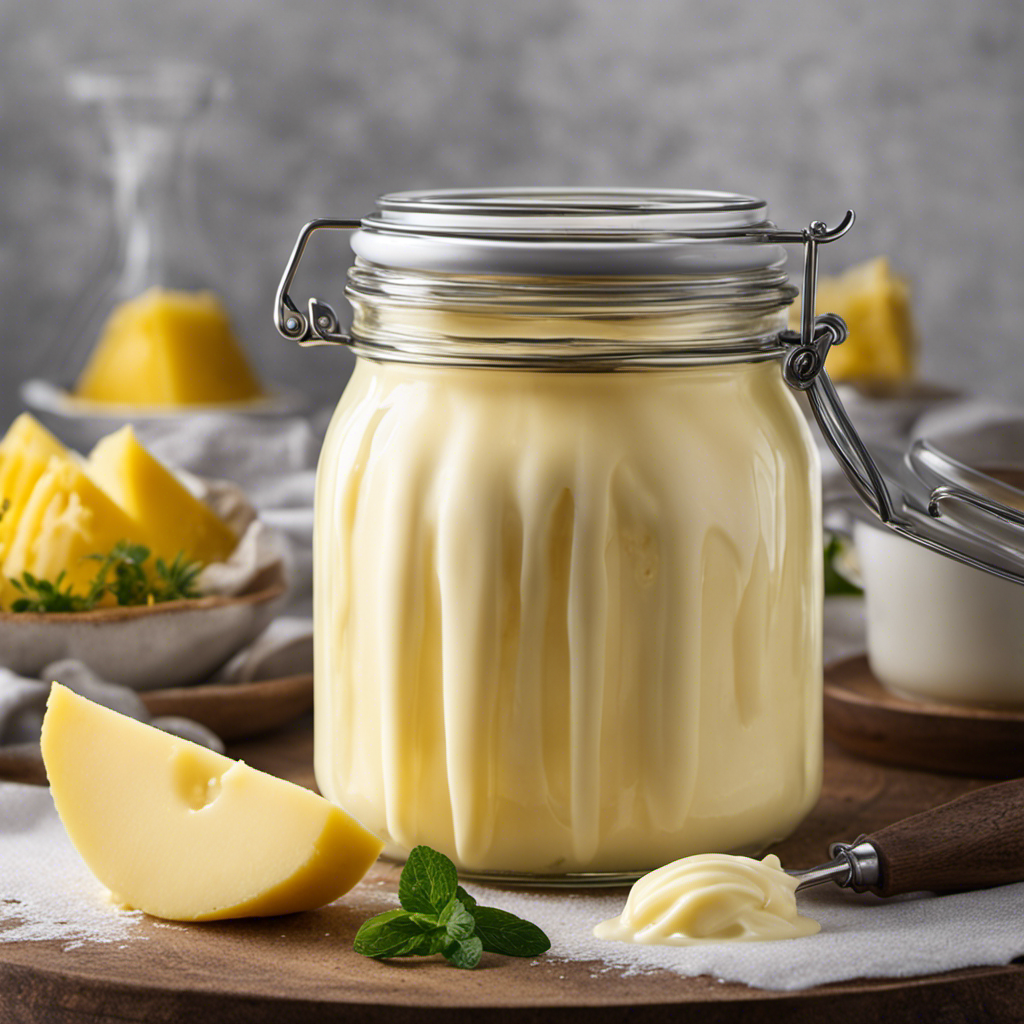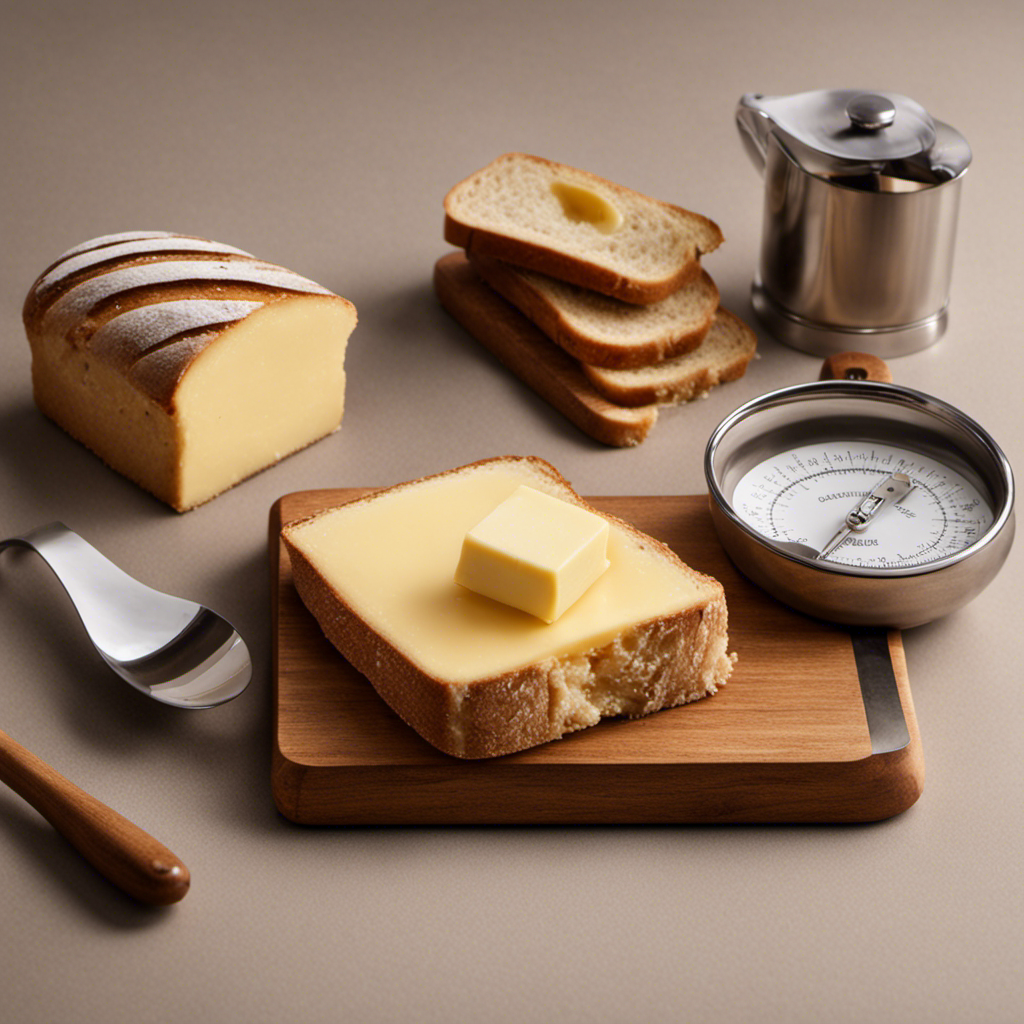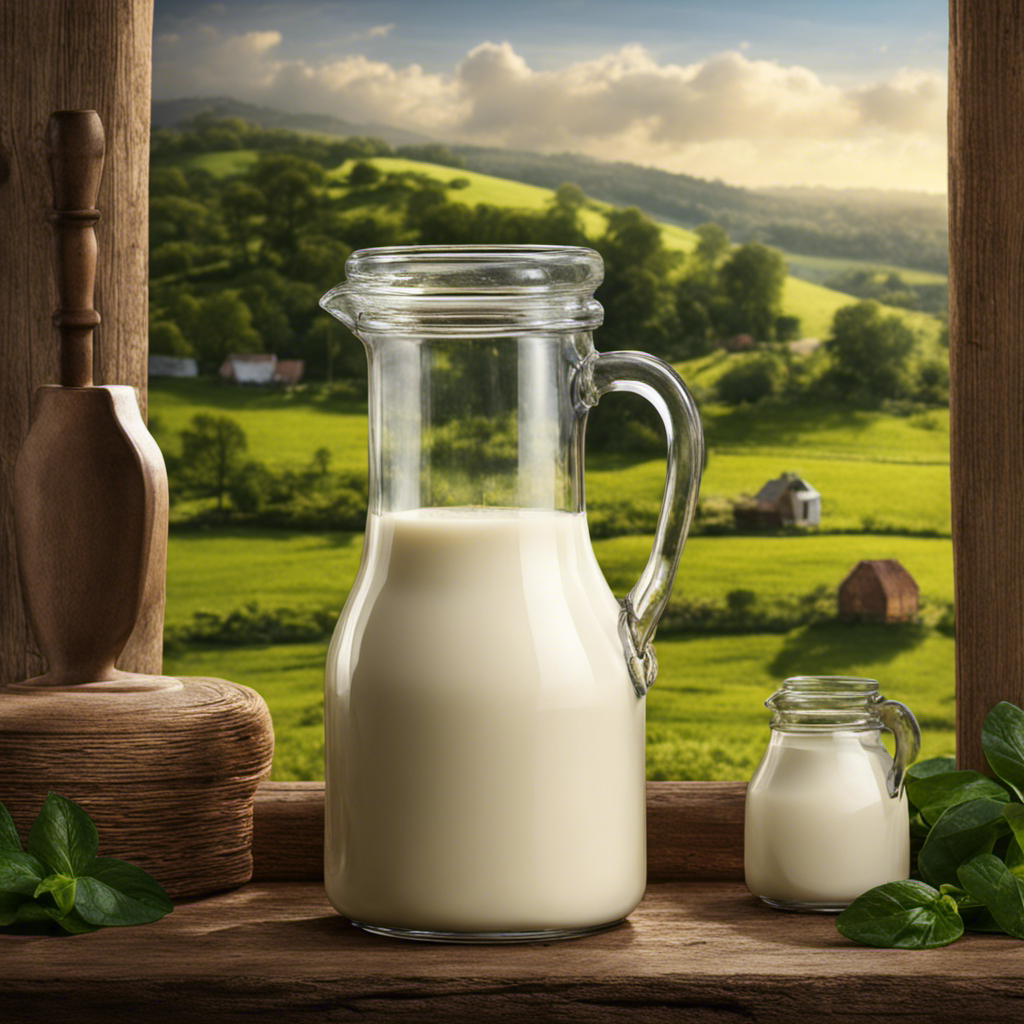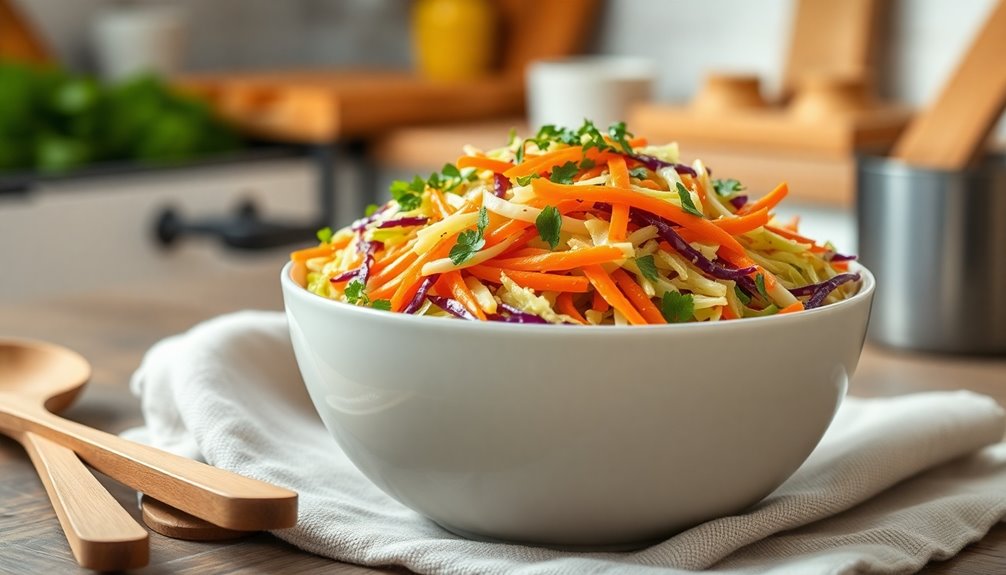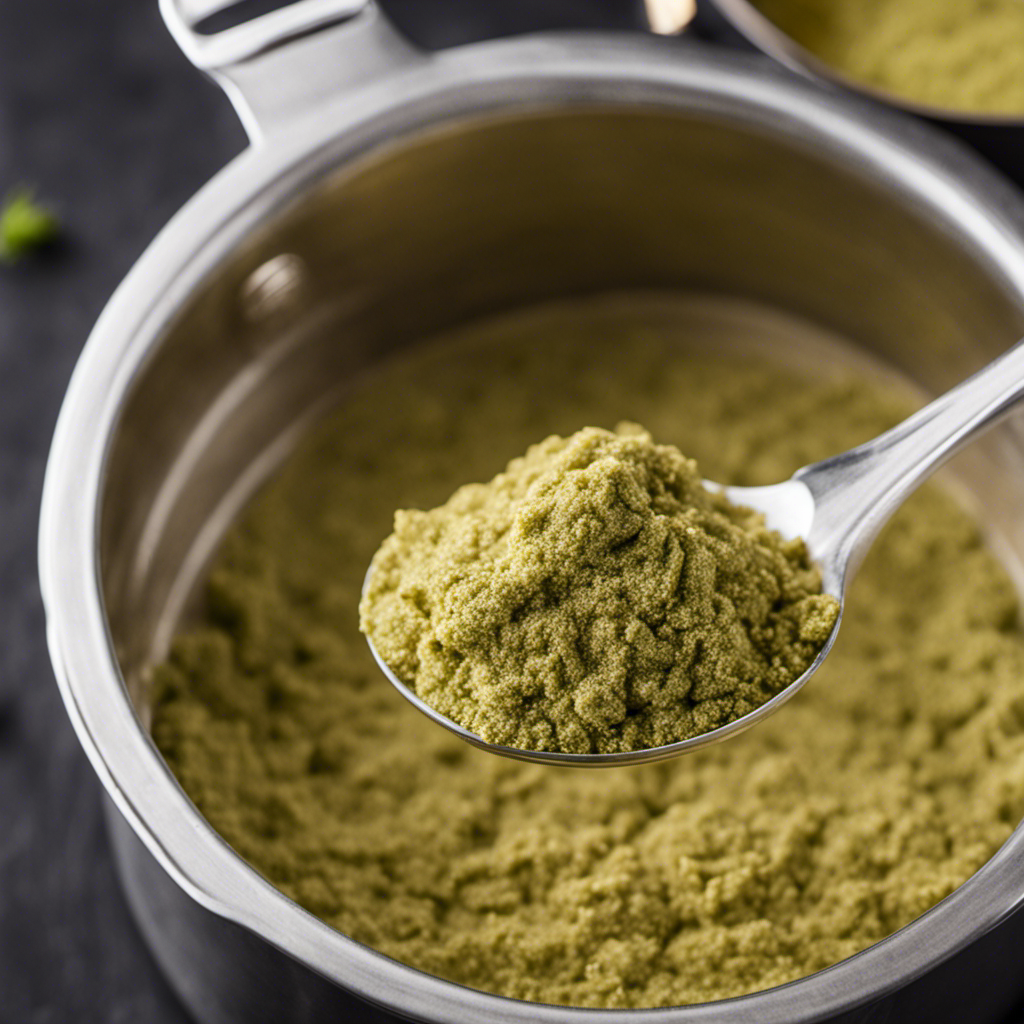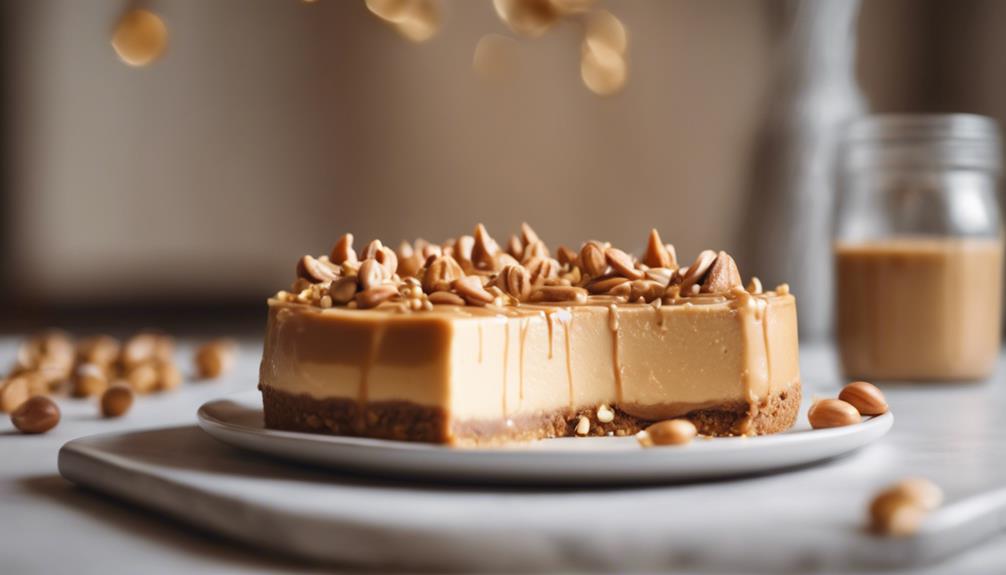When life hands you cream, make butter. That’s precisely my plan for this article.
Join me as we dive into the science of butter making and unravel the mystery behind the butter-to-cream ratio. We’ll explore the various factors that affect butter yield from cream and walk through a step-by-step process for churning cream into golden goodness.
Plus, I’ll share tips for storing and preserving homemade butter, as well as some mouthwatering recipes to put your freshly made butter to good use.
So, let’s grab our aprons and get ready to churn!
Key Takeaways
- The amount of butter produced from a quart of cream can vary depending on the fat content.
- Generally, a quart of cream can yield around 1.5 to 2 pounds of butter.
- Cream with a higher fat content will result in a higher yield of butter.
- The butter-to-cream ratio during the churning process determines the amount of butter produced.
The Science of Butter Making
The science of butter making involves separating the fat from cream. Butter making techniques have evolved over time, with various methods being used throughout history.
In ancient times, butter was made by churning milk in animal skin bags or wooden containers. Later, the use of churns became popular, where cream was agitated until the fat globules clumped together to form butter.
Today, modern butter making techniques involve using cream separators to separate the fat from milk, followed by churning the cream to create butter. Understanding the butter-to-cream ratio is crucial in determining how much butter can be made from a given amount of cream. This ratio depends on factors such as the quality of the cream and the desired fat content in the butter.
Understanding the Butter-to-Cream Ratio
To understand the butter-to-cream ratio, you should know that it depends on the amount of fat content in your cream. The higher the fat content, the more butter you can expect to yield. Here are four key points to consider when it comes to understanding this ratio:
-
Cream separation: When cream is left to stand, the fat rises to the top, forming a layer of cream that is higher in fat content than the rest of the liquid.
-
Butter fat content: The fat content in cream can vary, with heavy cream typically containing around 36-40% fat, while light cream has around 20-30% fat.
-
Churning process: The churning process involves agitating the cream to separate the fat from the liquid. The longer you churn, the more fat will accumulate, resulting in a higher butter-to-cream ratio.
-
Butter yield: The butter yield refers to the amount of butter you can obtain from a given quantity of cream. This yield is influenced by factors such as fat content, churning time, and cream quality.
Understanding the butter-to-cream ratio is just the first step in determining how much butter you can make. Now let’s explore the factors that affect the butter yield from cream.
Factors Affecting Butter Yield From Cream
Understanding the factors that affect butter yield from cream is essential for maximizing your butter-making potential.
When it comes to making butter, there are several key factors that can impact the amount of butter you will get from a given quantity of cream.
The first factor is the fat content of the cream. Cream with a higher fat content will generally yield more butter.
Additionally, the temperature at which the cream is churned can also affect butter yield. Churning cream at a slightly lower temperature can result in a higher butter yield.
Lastly, the agitation or churning process itself plays a crucial role in butter production. Properly agitating the cream helps to separate the butterfat from the liquid, resulting in a higher overall butter yield.
Step-by-Step Butter Making Process
Start by ensuring that you have all the necessary ingredients and equipment for the butter making process. Here is a step-by-step guide to making butter:
-
Gather your ingredients: You will need heavy cream, salt (optional), and any other flavorings you desire.
-
Prepare your equipment: Make sure you have a stand mixer or hand mixer, a mixing bowl, a strainer or cheesecloth, and a container for storing the butter.
-
Whip the cream: Pour the cream into the mixing bowl and beat it on medium-high speed until it thickens and separates into solid butter and buttermilk.
-
Rinse the butter: Place the butter in the strainer or cheesecloth and rinse it under cold water to remove any remaining buttermilk. This step helps to preserve the butter’s freshness.
Tips for Churning Cream Into Butter
When it comes to making butter, understanding the cream to butter ratio is crucial. Achieving the perfect balance between cream and butter ensures a creamy and rich end product.
In this discussion, I will delve into the science behind the cream to butter ratio and explain the various churning techniques that can be employed to create the perfect batch of butter.
Cream to Butter Ratio
The cream-to-butter ratio determines how much butter can be made from a quart of cream. It is important to understand this ratio in order to achieve the desired consistency and yield of butter.
Here are four key factors to consider when determining the cream-to-butter ratio:
-
Cream consistency: The consistency of the cream plays a crucial role in the butter-making process. Cream with a higher fat content will yield a higher amount of butter. Look for cream with a fat content of at least 36% or higher for optimal results.
-
Churning time: The length of time the cream is churned affects the amount of butter produced. Over-churning can lead to a drier butter, while under-churning may result in a lower yield.
-
Temperature control: The temperature of the cream during churning is essential. Keeping the cream at a consistent temperature, around 50-55°F (10-13°C), helps to ensure proper churning and butter formation.
-
Cream quality: Using high-quality cream is vital for making good butter. Look for fresh, organic cream from grass-fed cows for the best flavor and texture.
Churning Techniques Explained
To achieve the desired consistency and yield of butter, you should focus on mastering different churning techniques. The success of butter making depends not only on the quality of the cream, but also on the method used to churn it. There are various churning equipment available, each with its own advantages and disadvantages. The most common types of cream used for butter making are heavy cream, light cream, and whipping cream. The table below provides a comparison of these cream types:
| Cream Type | Fat Content (%) | Churning Time (minutes) |
|---|---|---|
| Heavy Cream | 36-40 | 15-20 |
| Light Cream | 18-30 | 20-30 |
| Whipping Cream | 30-36 | 10-15 |
Understanding the characteristics of different cream types and mastering the churning techniques will allow you to achieve the best results when making butter.
How to Store and Preserve Homemade Butter
When it comes to storing homemade butter, there are a few key techniques that can ensure its freshness and longevity. Proper butter storage techniques involve using an airtight container or wrapping the butter tightly in wax paper or plastic wrap.
Additionally, preserving butter freshness can be achieved by keeping it refrigerated and away from strong odors. These methods will not only help maintain the quality of your homemade butter but also extend its shelf life for you to enjoy it longer.
Butter Storage Techniques
You can store your homemade butter in an airtight container in the refrigerator. Here are four key points to consider when it comes to butter storage techniques:
-
Butter storage containers: It is essential to choose the right container for storing your homemade butter. Opt for a container that is airtight and made of food-grade material, such as glass or BPA-free plastic. This will help to preserve the flavor and quality of the butter.
-
Butter storage temperature: Butter should be stored at a consistent temperature to maintain its freshness. The ideal temperature for storing butter is between 32 and 40 degrees Fahrenheit (0 to 4 degrees Celsius). This will prevent the butter from melting or becoming too hard.
-
Proper sealing: Ensure that the container is tightly sealed to prevent any air or moisture from entering. This will help to extend the shelf life of the butter and maintain its texture.
-
Labeling and date marking: To keep track of the freshness of your homemade butter, it is advisable to label the container with the date of preparation. This will help you determine its shelf life and avoid using expired butter.
Preserving Butter Freshness
Now that we have discussed the different techniques for storing butter, let’s delve into preserving its flavor and extending its shelf life.
Preserving the freshness of butter is essential to ensure its taste remains intact for as long as possible. One way to achieve this is by properly wrapping the butter in an airtight container or using wax paper to prevent exposure to air and moisture.
Another effective method is to store the butter in the refrigerator, where the cooler temperature helps slow down the oxidation process. Additionally, you can consider using butter bells or butter crocks, which keep the butter fresh by sealing it in a water-filled chamber.
By implementing these techniques, you can enjoy the rich taste of fresh butter for an extended period.
Now, let’s explore the longevity of homemade butter.
Homemade Butter Longevity
To ensure your homemade butter stays fresh for longer, storing it in an airtight container or using wax paper can help maintain its flavor.
Here are four key factors to consider when it comes to homemade butter storage and extending its shelf life:
-
Temperature: Keep your homemade butter refrigerated at a temperature between 32°F (0°C) and 41°F (5°C). This helps prevent bacterial growth and slows down oxidation.
-
Moisture: Butter absorbs odors and flavors easily, so it’s important to store it in an airtight container or wrap it tightly with wax paper to protect it from moisture and external contaminants.
-
Light: Exposure to light can cause butter to spoil faster. Store it in a dark place or choose a butter dish with a lid that blocks out light.
-
Rotation: Homemade butter should be used within two to three weeks for optimal freshness. Rotate your stock regularly to ensure you’re using the oldest butter first and avoid waste.
Recipes and Ideas for Using Freshly Made Butter
There are plenty of recipes and ideas for using freshly made butter. One simple and delicious way to enjoy it is by spreading it on warm bread or toast. The creamy texture and rich flavor of homemade butter can elevate any breakfast or snack.
Another idea is to use it as a cooking fat for sautéing vegetables or frying eggs. The high smoke point of butter makes it a great option for searing meats or roasting vegetables as well.
Additionally, homemade butter can be incorporated into various baked goods, adding a rich and buttery taste. From cookies to cakes, the possibilities are endless.
With so many recipes and ideas available, it’s easy to make the most out of your freshly made butter.
Frequently Asked Questions
Can I Use Any Type of Cream to Make Butter?
Yes, you can use any type of cream to make butter. However, heavy cream with a high fat content is recommended for better results. The higher the fat content, the more butter you’ll be able to produce from a quart of cream.
How Long Does It Take to Churn Cream Into Butter?
When churning cream into butter, the temperature plays a crucial role. The optimal temperature for making butter is around 55°F. Traditional methods of churning may take hours, while modern techniques can yield butter in minutes.
Can I Add Flavorings or Seasonings to the Butter While Churning?
Adding flavorings or seasonings to butter while churning can enhance its taste and versatility. It allows for customizing the butter to suit personal preferences or specific recipes, opening up a world of flavor possibilities.
Can I Use a Food Processor or Blender Instead of a Churn to Make Butter?
Using a food processor or blender instead of a churn to make butter is possible. However, it may not yield the same results in terms of texture and flavor. Churning in a churn is the recommended method for optimal butter production.
How Long Can Homemade Butter Be Stored and How Should It Be Stored?
I’ve researched proper storage options for homemade butter. It should be stored in an airtight container in the refrigerator. The butter can last up to 2-3 weeks if properly packaged.
Conclusion
In conclusion, the process of making butter from cream is a fascinating science. By understanding the butter-to-cream ratio and the factors that affect butter yield, we can achieve the desired results.
With the step-by-step butter making process and helpful tips, churning cream into butter becomes an achievable task.
And once you have your homemade butter, storing and preserving it properly is crucial.
So, why not give it a try? You’ll be amazed at the transformation of a simple quart of cream into a luxurious and delicious butter masterpiece.
